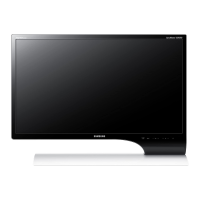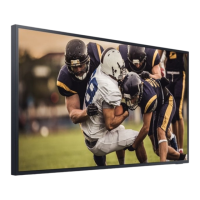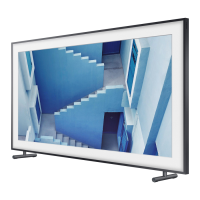Do you have a question about the Samsung LED 6700 series and is the answer not in the manual?
Learn how to scroll through the pages of the e-Manual using the scroll bar or touchpad.
Understand the function of Back, Forward, and Opened pages icons for navigation.
Discover how to navigate back to the e-Manual's main home page.
Access and use the index to find specific terms within the e-Manual.
Learn how to search for specific phrases or content within the e-Manual.
Directly navigate to specific menu items or related sections within the e-Manual.
Understand the process for updating the embedded e-Manual to the latest version.
Connect video devices using HDMI cables for optimal picture quality.
Connect video devices using component cables for good picture quality.
Connect audio and video devices using standard AV cables.
Connect audio devices using an optical cable for high-quality digital audio.
Connect audio devices to the TV's audio output connector.
Utilize ARC via HDMI for digital sound output, simplifying connections.
Connect your computer to the TV via HDMI for the best picture quality.
Connect computers without HDMI using an HDMI-to-DVI cable.
Automatically scans and indexes available channels for TV viewing.
Set the country or area for correct auto-tuning of broadcasting channels.
Manually scan and store channels in the TV's memory.
Scan for digital channels by setting channel, frequency, and bandwidth.
Scan for analogue channels by setting programme, colour, sound, and channel.
Change the order of digital channels by name or number.
Organize channels into categories like All, TV, Radio, Analogue, etc.
Organize favourite channel lists for easier switching.
Remove unwanted channels from the channel index.
Change the assigned number for channels in the edit channels list.
Add channels to your favourite channels list for quick access.
Remove channels from a favourites channels list.
Change the order of channels within a Favourites Channels List.
Rename existing favourite channels lists.
Connect the TV to a Local Area Network (LAN) using a wired connection.
Understand the difference between dynamic and static IP addresses for network setup.
Important considerations for using a wireless network connection.
Details on supported wireless network security protocols and compatibility.
Automatically configure the TV's wired network connection using DHCP.
Manually configure network settings like IP address, subnet mask, and gateway.
Connect wirelessly by selecting a network and entering the security key.
Manually connect to a wireless network using static IP settings.
Connect a mobile device directly to the TV without a wireless router.
Configure settings for playing media files from DLNA-enabled devices.
Assign a unique name to your TV for network identification.
Instructions for inserting batteries into the Smart Touch Control.
Pair the Smart Touch Control with the TV via Bluetooth for operation.
Steps to re-establish the connection between the TV and the control.
Understand the low battery indicator and replacement advice.
Overview of buttons on the remote and their functions.
Access special functions by pressing and holding specific control buttons.
Move the cursor or pointer by dragging your finger on the touchpad.
Scroll screens or move the cursor based on flick direction and speed.
Tap and hold the touchpad to display lists or access hidden features.
Move selected items or your location on maps by pressing and dragging.
Horizontally scroll lists or panels using the touchpad's edge.
Vertically scroll webpages or lists using the touchpad's edge.
Enter channel numbers via the touchpad to switch channels.
Follow sequence diagrams for accurate numerical input recognition.
Customize touchpad sensitivity for a more convenient user experience.
Display the status and notification banner on the screen.
View and select recommended programmes or launch applications.
View a list of recently accessed channels, media, and applications.
Remove history information about recently viewed channels, content, and apps.
Search for apps, content on TV, and information on the Web.
Select which panel (number, playback, quick access) to display on screen.
Adjust the position of the virtual remote panel on the screen.
Enter numbers on keypads or change channels using the number panel.
Control media playback functions like pause, rewind, and fast forward.
Quickly access buttons like INFO, MENU, and e-Manual.
Resize the virtual remote control window for better usability.
Connect the IR EXTENDER CABLE for universal remote control functionality.
Set up universal remote function for external devices.
Manage connected external devices, including source setup and renaming.
Enter text using the on-screen keypad with the remote control.
Use the QWERTY keypad like a normal keyboard for text entry.
Access features like Language, Recommend text, and Predict Next Letter.
Understand the precautions and how face recognition works.
Information regarding the legal and privacy aspects of using the TV camera.
Control TV functions using hand gestures via the camera.
Control TV functions using voice commands.
Configure language and TV voice responses for voice recognition.
Use voice commands for various TV operations like setting timers or launching apps.
Learn how to turn off the Voice Recognition feature.
Test the environment for optimal motion control recognition.
Learn the basics of using Motion Control through a guided tutorial.
Activate Motion Control by performing specific hand gestures.
Understand fundamental motion commands like pointing, selecting, and returning.
Adjust settings like animated guide, environment test, and pointer speed.
View icons and descriptions for Motion Control while watching TV.
Understand icons for Motion Control when used within Smart Hub.
Learn how to make icons reappear on the screen during Motion Control.
Register your face for secure login into your Smart Hub account.
Log into Smart Hub using your registered face recognition data.
Connect a USB or Bluetooth keyboard for easier text entry.
Learn the keyboard keys used to control the TV.
Connect a USB or Bluetooth mouse to control the TV interface.
Understand the mouse buttons and wheel functions for TV control.
View information about the current programme, requires TV clock to be set.
View digital channel programming schedules and set schedule viewing/recording.
Start recording the programme currently airing.
Browse the programming schedule forward or backward in time.
Set a schedule to watch programmes that haven't aired yet.
Set a schedule to record programmes that haven't aired yet.
View detailed information about a selected programme.
Organize the channel list by name or number.
Select channels based on their genre when in Added Channels mode.
Switch between Added Channels or Favourites lists.
Set up schedule viewing for programmes on digital channels.
Set up schedule viewing for programmes on analogue channels.
Remove a scheduled viewing from the Schedule Manager.
Modify the settings of an existing scheduled viewing entry.
Important notes and warnings regarding schedule recording.
Configure external storage as a dedicated recording device.
Options for recording programmes: Instant Recording, Guide, Programme Info.
Select a viewing mode to sort the list of recorded programmes.
Filter the list to show only specific recorded programmes.
Create a playlist of selected recorded programmes.
Lock or unlock recorded programmes to prevent unauthorized access.
Remove recorded programmes from the storage device.
Rename recorded programmes for better identification.
Designate a connected device as a dedicated recording device.
Select and play different programmes from the recorded list.
Scan through programmes backward/forward or change playback speed.
Important safety and usage notes for the Timeshift function.
Learn how to activate and use the Timeshift feature to pause live TV.
Read health and safety information concerning 3D viewing.
Useful tips for optimizing the 3D viewing experience.
Choose and activate a 3D mode based on the input signal.
Adjust 3D perspective, depth, and L/R swap for enhanced 3D content.
Activate and set options for Picture-in-Picture viewing.
Configure sub-picture channel, size, position, and audio source.
Adjust analogue pictures to clear shaky images and reduce noise.
Set primary and secondary audio languages for digital channels.
Change the desired audio format for digital channels.
Enable/disable and adjust volume for audio description.
Turn subtitles on or off for broadcasts that support them.
Set the preferred mode for displaying subtitles.
Select the language for displaying subtitles.
Set the primary subtitle language.
Set the secondary subtitle language.
Select and adjust picture modes like Dynamic, Standard, and Natural.
Adjust backlight or cell light for brightness and power consumption.
Adjust the screen contrast for better image definition.
Adjust the overall brightness of the TV screen.
Sharpen or soften the edges of objects in the picture.
Adjust the overall colour saturation for vibrant images.
Adjust the ratio of green to red for colour balance.
Apply current picture quality settings to all inputs or the current input.
Automatically adjusts picture size to 16:9 aspect ratios.
Set the picture to the standard 16:9 wide-screen format.
Magnify pictures larger than 4:3, with adjustable position.
Magnify 16:9 pictures vertically to fit the screen size.
Set the picture to the basic 4:3 aspect ratio.
Display the full image without any part being cut off.
Reduce 16:9 picture by 50% (LED TVs, HDMI mode).
Reduce 16:9 picture by 25% (LED TVs, HDMI/DTV mode).
Adjust the screen position when Wide Zoom or Zoom is selected.
Determine desired picture size in 4:3 WSS or original size.
Enable Sports Mode for optimal sports viewing experience.
Automatically adjusts screen contrast for optimal settings.
Adjust the black colour depth for better contrast.
Adjust the amount of red in skin-colour tones.
Adjust red, green, and blue levels individually.
Adjust the range of colours expressed on screen (Auto, Native, Custom).
Adjust colour temperature and luminosity for natural white balance.
Adjust white balance by modifying RGB elements in 10-point intervals.
Adjust the primary colour intensity.
Display calibration patterns for contrast and colour adjustment.
Adjust brightness based on on-screen movement to reduce power consumption.
Adjust the colour tone for individual picture modes.
Reduce static and ghosting from weak signals.
Reduce MPEG noise to improve video quality.
Adjust black level to compensate for HDMI connection issues.
Optimize picture quality for movies.
Reduce motion blur and judder for smoother images.
Reduce diagonal noise caused by signal crosstalk.
Adjust black depth for a more immersive viewing experience.
Remove motion drag from fast scenes for a clearer picture.
Select sound modes like Standard, Music, Movie, Clear Voice, Amplify, Stadium.
Produce immersive sound like a movie theatre or concert hall.
Increase voice intensity for clearer dialogue.
Adjust speaker balance and bandwidth settings.
Automatically adjust volume levels for consistent sound output.
Enhance sound to match 3D video for a more immersive experience.
Select sound output based on TV installation (Stand or Wall Mount).
Reset all sound settings to factory defaults.
Choose which speakers to use (TV, AV receiver, or both).
Connect to Samsung audio devices for richer sound via Bluetooth.
Configure additional settings for optimum audio output.
Set digital audio volume for AV receivers at a comfortable level.
Select the Digital Audio output (SPDIF) format.
Correct timing mismatches between audio and video tracks.
Manually or automatically set the TV's clock.
Adjust the time difference hourly from -12 to +12 hours.
Automatically shut off the TV after a preconfigured time period.
Set the TV to turn on automatically at a chosen time.
Set the Off Timer to turn the TV off automatically at a specific time.
Adjust brightness and prevent overheating to reduce power consumption.
Select a brightness setting to reduce TV's power consumption.
Automatically adjusts brightness based on ambient light.
Automatically cut power if no signal is received for a specified duration.
Automatically turn off the TV after four hours of inactivity.
Shift pixels slightly to prevent screen burn-in.
Activate screen saver to prevent burnt-in ghost images.
Remove after-images by illuminating pixels according to a set pattern.
Select sidebar colours for 4:3 screen size.
Activate screen burn protection if a still image is displayed.
Change the TV's password for channel locking and factory reset.
Select the desired language for the TV's menu interface.
Important information before using Game Mode for gaming.
Optimize picture quality and resolution when connecting compatible devices.
Adjust the transparency level of the menu screen.
Adjust the volume or disable audio cues for focus movement.
Lock or unlock the TV's front panel keys.
Enable or disable the display of the logo during TV startup.
Change power frequency to stop camera flickering.
Register for DivX® DRM to play protected videos.
Access social networking services and video calls.
Download and install applications like WebBrowser.
View current and scheduled programmes, and watch recorded TV.
Play media files from external storage or watch recorded videos.
Read and agree to terms and conditions for full Smart Hub functionality.
Create a Samsung account using your email address.
Simplify Samsung account creation using a Facebook account.
Review terms and conditions before agreeing to use Samsung Account.
Log into Smart Hub using your Samsung account ID and password.
Link service accounts (e.g., Facebook) for automatic login.
Manage your Samsung account, edit profile, and remove accounts from TV.
Remove Samsung accounts, apps, and linked items from the TV.
Search for apps and content on the TV and the Web.
Display the status and notification banner at the top of the screen.
Configure status banner functions for Voice Recognition and Motion Control.
Manage your Samsung account via the status and notification banner.
Configure network settings through the status and notification banner.
View alarm messages and perform actions on notifications.
Configure settings for using the Social feature.
Ensure necessary applications are installed to use Social features.
Link social service accounts to your Samsung account.
Select and play videos from Friends' Picks or What's Hot.
View friends' profiles and basic information.
Initiate a video call to a friend via Skype.
Use filter options to rearrange lists on the Social screen.
Understand limitations and requirements for Samsung Smart Hub apps.
Automatically download and install basic applications.
Open installed applications from the Apps screen.
Search for and install free and paid applications.
Find applications by entering their name.
Download and install applications, including purchasing paid ones.
Customize My Apps screen, manage installed apps, and update settings.
Move applications to My Apps for customization.
Remove unused applications from the My Apps list.
Add installed applications that do not appear in the My Apps list.
Delete installed applications and associated data.
Create and manage folders to group applications.
Lock or unlock applications to restrict access.
Update applications to the latest version.
Create a profile and set up an exercise plan for staying fit.
Enter your information to create a fitness profile.
Access a launcher and list of child-friendly applications and content.
Browse the Internet on your TV, similar to a computer.
Share thoughts and comments on aerial programmes via social networking services.
Link SNS accounts to Samsung account for seamless access.
Enjoy 3D VoD content, including movies, concerts, and documentaries.
Configure tickers to display stock values, news, and weather updates.
Enable/disable push notifications from applications.
Use apps that support current programme data services.
View Apps version, TV serial number, and memory capacity.
View programme guide and programme information more easily.
Set broadcast media type and TV stations for the On TV screen.
Receive notifications for popular TV programmes currently airing.
Determine whether to display upcoming TV programmes by preference or popularity.
Hide adult TV programmes from the On TV screen.
Configure Smart Hub to automatically launch when the TV is turned on.
Select a recommended programme to change to its channel.
View info and times for upcoming recommended programmes.
Launch the Guide to view programming information.
Display programme recommendations for different times of the day.
Launch Recorded TV to watch previously recorded programmes.
Understand limitations for USB devices, file systems, and high-power input.
List of supported file formats for photos, music, videos, and subtitles.
Connect USB devices to play stored media files.
Safely remove USB devices using the Source screen.
Play all content saved on a storage device regardless of type.
Launch Recorded TV to view previously recorded programmes.
Clear thumbnails of recently-played media files.
Select devices connected to the same network to allow TV access.
Retrieve and enjoy media files from computers and DLNA-enabled devices.
Send contents to different storage devices (e.g., USB to DLNA).
Select a category to sort the video file list.
Create a playlist of selected video files.
Select and play different video files or use title search.
Scan video files in 10-second increments or change playback speed.
Display subtitles if a subtitle file matches the video file name.
Set repeat mode for current file or all files in a folder.
Select the picture size for video playback.
Rotate the current video 90 degrees clockwise.
Select the receiver and power it on.
Select a picture mode for video playback.
Select a sound mode for video playback.
Select an audio language for streaming videos.
View detailed information about the current video.
Select a category to sort the music file list.
Create a playlist of selected music files.
Scan music files in 10-second increments or pause playback.
Set repeat mode for current file or all files in a playlist.
Play music files in normal or random order.
Select the receiver and power it on.
Select a sound mode for music playback.
View detailed information about the selected music file.
Select a category to sort the photo list.
View all photos in the list as a slideshow.
Adjust slideshow speed and effects.
Create a playlist of selected photos.
Select and play different photo files.
Enable music to play in the background during a slideshow.
Control background music playback for photos.
Notes on compatibility, cable requirements, and device operation.
Enable/disable Anynet+ (HDMI-CEC) and auto turn-off features.
Operate compatible Samsung external devices using the TV remote.
Access device menus, tools, and titles via the TV remote.
Enable digital sound output via HDMI using ARC.
Display mobile device screens on your TV wirelessly.
Wirelessly display mobile device screens supporting AllShare Cast.
Connect mobile devices to the TV for screen mirroring.
Allow Samsung technicians to diagnose and repair your TV remotely.
Understand the services offered by Samsung Remote Support technicians.
Step-by-step guide on how Samsung remote servicing works.
Access the built-in electronic user manual for comprehensive guidance.
Diagnose picture, sound, and signal issues with built-in tools.
Display a high-definition picture to check for flaws or faults.
Check for sound problems using a built-in melody.
Test ambient noise and brightness for SMART Interaction suitability.
View digital channel signal information and strength.
Reset all settings to factory defaults, except network settings.
Check for and upgrade TV software via update now, manual, or auto update.
Select the TV's usage mode (e.g., Home Use, Store Demo).
Check product information and instructions for obtaining the latest software.
Activate, store, size, hold, reveal, and cancel Teletext pages.
Select topics on Teletext pages using coloured buttons.
Select Teletext modes like LIST or FLOF.
Display available sub-pages within Teletext.
Navigate through Teletext pages using Page Up and Page Down.
Resolution specifications for LED 5300+ and PDP 5500 series TVs.
Resolution specifications for LED 4500 series TVs.
Supported 3D resolutions for HDMI input (L/R, T/B, Frame Packing).
Supported 3D resolutions for Component input.
Supported 3D resolutions for Digital Channel input.
List of external and internal subtitle file formats.
List of supported image file extensions and their resolutions.
List of supported music file extensions, types, and codecs.
Details on supported video codecs, containers, resolutions, and bit rates.
Notes on codec functionality and potential playback issues.
Information on supported and unsupported video decoder specifications.
Information on supported and unsupported audio decoder specifications.
Important health and safety information for using the 3D function.
Steps to follow when making a warranty claim for the product.
Details of warranty validity, exclusions, and limitations.
Information about DivX certification for video playback.
Details on DTS audio technologies and trademarks.
Tips for flickering or dimming issues, including disabling energy saving features.
Troubleshoot incorrect screen colour or black/white issues.
Adjust brightness, contrast, and other settings for picture quality.
Correct blur or 'ghost' shadows using Motion Plus.
Troubleshoot unexpected TV power-off issues.
Check connections and power for issues with powering on the TV.
Run Setup or Auto Tuning to find channels.
Tips for improving image quality compared to store displays.
Understand causes of picture distortion like compression or weak signals.
Troubleshoot colour issues related to component connections.
Adjust picture settings and check energy saving features.
Adjust picture size settings if a dotted line appears on screen.
Check AV composite input connections for colour issues.
Troubleshoot channel change issues by resetting cable box or adjusting resolution.
Check connected device volume and sound settings.
Verify speaker select, audio output options, and cable connections.
Check audio cable connections and signal information for distortions.
Troubleshoot 3D glasses not working by checking power and interference.
Optimize 3D viewing distance and eye level alignment.
Conserve battery life by turning off 3D glasses when not in use.
Check coaxial cable connection and run Auto Tuning.
Adjust Subtitle Mode setting for digital channels.
Understand causes of distortion like compression or weak signals.
Set PC output resolution to match TV supported resolutions.
Check PC audio output settings and cable connections.
Ensure TV is connected to a wireless IP router and check connection status.
Check network status and ensure connectivity for software updates.
Understand normal panel heat dissipation and safety precautions.
Adjust picture size options for HD channels or different aspect ratios.
Check TV supported resolutions and adjust external device output.
Subtitle menu unavailable with HDMI/Component sources or external device.
Plastic smell is normal and will dissipate over time.
Reassemble the base stand if the TV is tilted.
Broadcasting menu available only when Source is TV.
Change Use Mode from Store Demo to Home Use.
Check cable connections and ensure flexibility for long-term use.
PIP functionality requires HDMI or Component source.
Change Use Mode from Store Demo to Home Use.
Popping noise from casing expansion/contraction is normal.
Humming noise may occur due to high-speed circuits and current.
Prevent PDP TV screen burn-ins using Pixel Shift and Screen Burn Protection.
Check USB device state, formatting, and try different devices if functions fail.
Check if USB device is locked and use USB recovery function.
Ensure USB device is connected and channel is digital for recording.
Use high-performance USB devices for recording and Timeshift.
Check device compatibility, cables, and Anynet+ settings.
Check device connection and Anynet+ settings, then select device.
Exit Anynet+ menu or switch to a non-Anynet+ device.
Wait for configuration to complete before using remote control.
Play function is unavailable during Setup.
Check device Anynet+ support, HDMI cable, and scan for devices again.
Connect optical cable or use HDMI (ARC) for receiver audio.
Understand potential playback issues with high-bitrate files.
Change application language based on service provider support.
Check with the service provider or refer to their website's help section.
Understand limitations like no Java/file downloads, restricted Flash, and scroll issues.
Notes on font support, response delays, copy/paste, and bookmark limits.
Web browsing speed varies depending on the network environment.
Embedded video disables PIP; reload page if playback fails.
Supports specific bookmark formats and saves to 'Samsung SmartTV Bookmark'.
Browsing history is saved if Clock is enabled; ordered latest to oldest.
Codec support may affect playback of certain files during Flash playback.
| HDMI Ports | 3 |
|---|---|
| USB Ports | 2 |
| WiFi | Yes |
| Display Technology | LED |
| Refresh Rate | 60Hz |
| Smart TV | Yes |
| 3D Capable | No |
| Contrast Ratio | Mega Contrast |
| Sound Output | 20W |
| Dimensions (Without Stand) | Varies by screen size |
| Weight (Without Stand) | Varies by screen size |
| Built-in Wi-Fi | Yes |
| Motion Rate | 120 |
| Screen Size | 55 |











